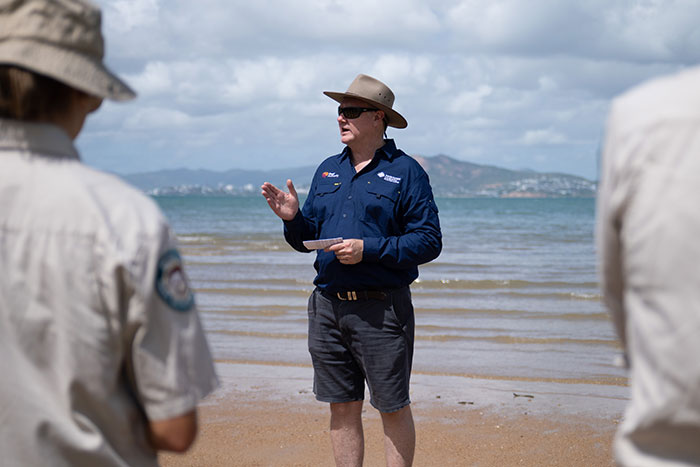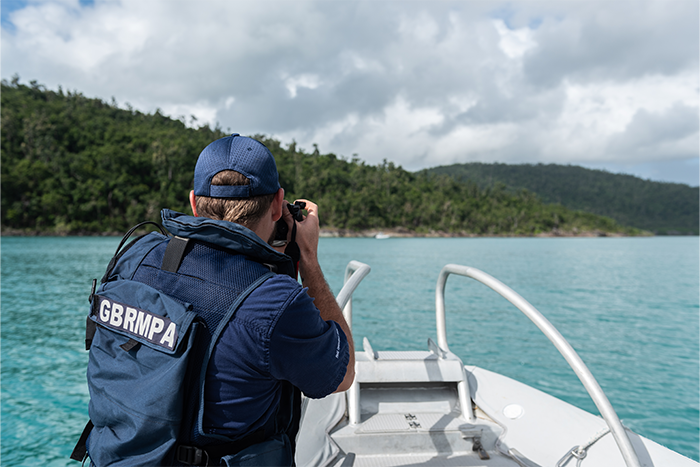There’s a rumour, rife around Reef Authority offices, of a chilli mud crab recipe that rivals almost all others. But there’s a catch, literally and figuratively.
“The secret to cooking the world’s best chilli mud crab,” says gourmet gatekeeper Richard Quincey, “is finding and catching the world’s best mud crab!” And he should know.
The Reef Authority’s General Manager of Marine Park Operations has spent the better part of his 30-year-career working to protect some of Queensland’s most iconic coastal environments and has witnessed firsthand how effective conservation management pays dividends for seminal species, including the humble mud crab.
“I actually started out with the Queensland Parks and Wildlife Service way back in in the mid-nineties,” Richard says.
“I had spent six months in Townsville when I was studying for my university degree, working with QPWS in a in a planning role and just fell in love with the north.” So much so, in fact, not even an idyllic, year-long stint fishing on K’Gari (Fraser Island) was enough to keep him away.
“It’s a nice place to spend 12-months living in a tent but I thought I thought I'd better get on and find a job and came back up to North Queensland; firstly, to Cardwell and then back to Townsville and always in a Queensland Parks and Wildlife marine area protected role, before I moved across to the Reef Authority.

“I've been very lucky that those opportunities have been there for me.”
Today, as a member of the Executive Management Team, Richard’s remit extends from the top of the Great Barrier Reef Marine Park in the Torres Strait, all the way to the southern reefs off Bundaberg in the south. It’s a responsibility he doesn’t take lightly, overseeing a portfolio that ranges from planning to permits, compliance to crown-of-thorns starfish control and almost everything in between.
“People use the Marine Park for a range of activities including boating, fishing, and snorkelling; doing things that don't involve take or manipulation of the environment, which is often fairly straight forward,” he says.
“But for those other things like commercial fishing and tourism activities for example, we run a permission system that simply makes sure that they do the right thing with minimal impact. And to ensure this runs smoothly we need to make sure that we have a presence, not just on paper, but across the entire 2300 kilometres of the Reef.”
And the key to maintaining an end-to-end presence across the breadth of the Marine Park is a long-standing partnership with the Queensland Government and the many dedicated field officers who make up the Reef Joint Field Management Program.

“So that's a really big part of what we do; looking at things like delivering conservation actions in the water and on islands,” he says.
“We look for change as the general practitioners of the Reef, not necessarily the specialist scientists, but we're there on the water and islands more than anyone else in many of the remote locations.
“We’re doing those observations, responding to incidents, making sure that there's infrastructure so people can come and use the Reef, but do it without leaving a trace.”
Over the warmer summer months, when the Reef is more vulnerable to weather impacts including cyclones and marine heatwaves, it’s Richard’s team that are often the first eyes and ears on the remote stretches of the Reef.
And, as the Reef slowly begins to recover from the fifth widespread bleaching event in the last decade, in-field monitoring and targeted management actions have never been more important.
“We have had disturbances in the past, and more recently, from both cyclones and thermal stress events causing coral bleaching and these are things that we've seen more frequently over the past few years,” Richards adds.
“We gather data from summer to summer in a local and regional context which is really important.”
For this, Richard and is team rely heavily on an extensive network of partners including the Australian Institute of Marine Science (AIMS), universities and research programs, Traditional Owners, and tourism operators, RJFMP rangers and the Reef Authority’s own Crown-of-thorns starfish Control Program.
“What we’ve seen is the Reef has recovered from some of those disturbances given it's had sufficient time to do so. It doesn't mean that they haven't impacted the Reef but what it does show is that we still manage a very resilient Great Barrier Reef, which is a positive sign.”
This is particularly important as the Reef faces unprecedented challenges from climate change.
“When I started in marine protected area management, the focus about just removing the direct human pressures and the Reef would look after itself. We've moved on in natural systems management from that. We're going to need to look at how we intervene, how we restore or repair or help a system be as resilient as it can be.
And for the two million-plus people that visit Australia’s greatest natural wonder every year, Richard says helping is as simple as downloading the Eye of the Reef app and reporting what you see.
But as to where you might see – and even catch - the world’s best mud crab?
“I do have a favourite spot… but that’s a family secret!”
